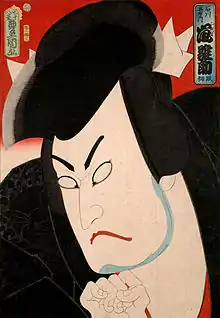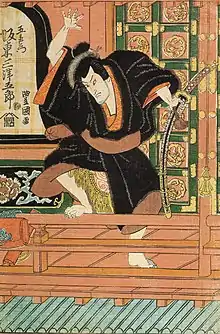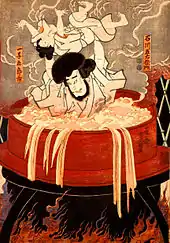Ishikawa Goemon
Ishikawa Goemon (石川 五右衛門, Ishikawa Goemon, August 24, 1558 – October 8, 1594) was a legendary Japanese outlaw hero who stole gold and other valuables to give to the poor.[1] He and his son were boiled alive in public after their failed assassination attempt on the Sengoku period warlord Toyotomi Hideyoshi. His legend lives on in contemporary Japanese popular culture, often giving him greatly exaggerated ninja skills.
Ishikawa Goemon 石川 五右衛門 | |
|---|---|
 Goemon as played by kabuki actor Arashi Hinasuke II (an 1863 painting by Toyokuni III) | |
| Born | August 24, 1558 |
| Died | October 8, 1594 (aged 36) |
| Cause of death | Execution by boiling |
| Nationality | Japanese |
| Occupation | Thief |
Biography

There is little historical information on Goemon's life, and as he has become a folk hero, his background and origins have been widely speculated upon. In his first appearance in the historical annals, in the 1642 biography of Hideyoshi, Goemon was referred to simply as a thief. As his legend became popular, various anti-authoritarian exploits were attributed to him, including a supposed assassination attempt against the Oda clan warlord Oda Nobunaga.[2][3]
There are many versions of Goemon's background and accounts of his life. According to one of them, he was born as Sanada Kuranoshin in 1558 to a samurai family in service of the powerful Miyoshi clan in Iga Province. In 1573, when his father (possibly Ishikawa Akashi[4]) was killed by the men of Ashikaga shogunate (in some versions his mother was also killed), the 15-year-old Sanada swore revenge and began training the arts of Iga ninjutsu under Momochi Sandayu (Momochi Tamba). He was, however, forced to flee when his master discovered Sanada's romance with one of his mistresses (but not before stealing a prized sword from his teacher). Some other sources state his name as Gorokizu (五郎吉) and say he came from Kawachi Province and was not a nukenin (runaway ninja) at all. He then moved to the neighbouring Kansai region, where he formed and led a band of thieves and bandits as Ishikawa Goemon, robbing the rich feudal lords, merchants and clerics, and sharing the loot with the oppressed peasants.[5] According to another version, which also attributed a failed poisoning attempt on Nobunaga's life to Goemon, he was forced to become a robber when the ninja networks were broken up.[6]

There are also several conflicting accounts of Goemon's public execution by boiling on the banks of the Kamo River in Kyoto,[7] including but not limited to the following ones:
- Goemon tried to assassinate Hideyoshi to avenge the death of his wife Otaki and the capture of his son, Gobei. He snuck into Fushimi Castle and entered Hideyoshi's room but knocked a bell off a table. The noise awoke the guards and Goemon was captured. He was sentenced to death by being boiled alive in an iron cauldron along with his very young son, but was able to save his son by holding him above his head. His son was then forgiven.[8]
- Goemon wanted to kill Hideyoshi because he was a despot. When he entered Hideyoshi's room, he was detected by a mystical incense burner. He was executed on October 8 along with his whole family by being boiled alive.[9] Goemon at first tried to save his son from the heat by holding him high above, but then suddenly plunged him deep into the bottom of the cauldron to kill him as quickly as possible. Then he stood with the body of the boy held high in the air in defiance of his enemies, until he eventually succumbed to pain and injuries and sank into the pot.[10]

Even the date of his death is uncertain, as some records say this took place in summer, while another dates it at October 8 (that is after middle of Japanese autumn). Before he died, Goemon wrote a famous farewell poem, saying that no matter what, thieves would always exist. A tombstone dedicated to him is located in Daiunin temple in Kyoto.[11] A large iron kettle-shaped bathtub is now called a goemonburo ("Goemon bath").[12][13]
In kabuki drama
Ishikawa Goemon is the subject of many classic kabuki plays. The only one still in performance today is Kinmon Gosan no Kiri (The Golden Gate and the Paulownia Crest), a five-act play written by Namiki Gohei in 1778.[14] The most famous act is "Sanmon Gosan no Kiri"[15] ("The Temple Gate and the Paulownia Crest") in which Goemon is first seen sitting on top of the Sanmon gate at Nanzen-ji. He is smoking an oversized silver pipe called a kiseru and exclaims "The spring view is worth a thousand gold pieces, or so they say, but 'this too little, too little. These eyes of Goemon rate it worth ten thousand!". Goemon soon learns that his father, a Chinese man named Sō Sokei, was killed by Mashiba Hisayoshi (a popular kabuki alias for Hideyoshi) and he sets off to avenge his father's death. He also appears in some versions of the famous Tale of the Forty-Seven Rōnin. In 1992, Goemon appeared in the kabuki series of Japanese postage stamps.[16]
In popular culture
There are generally two ways in which Goemon has been most often portrayed in the modern popular culture: either a young, slender ninja, or a powerfully-built, hulking Japanese bandit. He has been portrayed in literature, film, manga, anime, video games, and in other media.
Goemon was a subject of several pre-WWII Japanese films such as Ishikawa Goemon Ichidaiki and Ishikawa Goemon no Hoji.[17][18] He is a villain in Torawakamaru the Koga Ninja,[19] and a tragic antagonist in Fukurō no Shiro (and in its remake Owls' Castle, played by Takaya Kamikawa). He and his execution are mentioned in Ozu's silent film "A Story of Floating Weeds." He is the subject of the Shinobi no Mono novels and film series, starring Ichikawa Raizō VIII as Goemon in the first three installments. In the third Shinobi no Mono film, known in English as Goemon Will Never Die,[20] he escapes execution while another man is bribed to be boiled in his place. In the film Goemon, he is portrayed by Yōsuke Eguchi and depicted as Nobunaga's most faithful follower and as associated with Hattori Hanzō as well as Kirigakure Saizō and Sarutobi Sasuke of Sanada Ten Braves.
Goemon is the titular character of the long-running Konami video game series Ganbare Goemon as well as a television series based on it. Goemon appears in the video game series Samurai Warriors and Warriors Orochi, where he is a self-proclaimed king of thieves, wielding a giant mace and a back-mounted cannon, as well as in the video games Blood Warrior, Persona 5, Kessen III,[21] Ninja Master's: Haō Ninpō Chō (depicted as a giant bandit hero, also carrying a cannon and seeking to plunder Nobunaga's castle), Shogun Warriors, and Throne of Darkness, where he has been spared by Tokugawa Ieyasu on the condition that he would join the onimitsu.[22]
The method of poison delivery sometimes attributed to Goemon's supposed attempt to kill Nobunaga inspired Aki's death scene in the film You Only Live Twice.[23]
In the manga series Lupin III, the character Goemon Ishikawa XIII is a thirteenth-generation descendant of the original Goemon, and like him is an outlaw.
See also
References
- Boye Lafayette De Mente, Everything Japanese, McGraw-Hill, 1989 (p. 140)
- Joel Levy, Ninja: The Shadow Warrior, Sterling Publishing Company, 2008 (p. 172)
- Stephen Turnbull, Warriors of Medieval Japan, Osprey Publishing, 2007 (p. 180)
- Henri L. Joly, Legend in Japanese Art: A Description of Historical Episodes, Legendary Characters, Folk-lore Myths, Religious Symbolism, Tuttle 1967
- (in Polish) Skośnoocy buntownicy (Focus.pl - Historia) Archived 2011-07-25 at the Wayback Machine
- Andrew Adams, Ninja: The Invisible Assassins, Black Belt Communications, 1970 (p. 160)
- "A rogue on high". The Japan Times. 5 March 2010. Retrieved 2023-07-31.
- "A geek in Japan — Goemon". Kirainet.com. 12 March 2008. Retrieved 2013-12-01.
- The legend of Ishikawa Goemon Archived 2009-03-14 at the Wayback Machine (including several pictures)
- Jack Seward, The Japanese, McGraw-Hill Professional, 1992 (p. 48-49)
- Outlawed!: Rebels, Revolutionaries and Bushrangers, National Museum of Australia, 2003 (p. 32)
- Goemonburo - Goemon-style bath Archived July 6, 2011, at the Wayback Machine
- Scott Clark, Japan, a View from the Bath, University of Hawaii Press, 1994 (p. 38-39)
- James Brandon and Samuel Leiter, Kabuki Plays on Stage: Villainy and Vengeance, 1773 - 1799. Vol. II, Honolulu: University of Hawaii Press, 2002
- "Ishikawa Goemon". Kabuki21. Retrieved 2013-12-01.
- (in Japanese) 歌舞伎編 - www.geocities.jp Archived 2018-11-06 at the Wayback Machine
- Ishikawa Goemon ichidaiki (1912) - IMDb
- IMDb - Ishikawa goemon no hoji (1930)
- "Press stills from NINJUTSU GOZEN-JIAI". Vintage Ninja. Retrieved 2013-12-01.
- Shinobi No Mono 3: Resurrection (1963) - IMDb
- Kessen III Officer FAQ - IGN FAQs Archived August 20, 2008, at the Wayback Machine
- "Throne of Darkness Character Roles: The Ninja - PC Feature at IGN". Uk.pc.ign.com. 14 September 2000. Retrieved 2013-12-01.
- Shinobi no mono (1962) Movie Online Archived 2010-09-24 at the Wayback Machine
External links
- Goemon Ishikawa (character) at the Internet Movie Database
- Japan Inside Lexique : Ishikawa Goemon on YouTube (by Mangas TV) (in French)